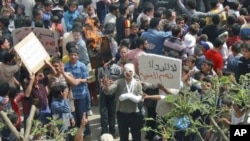The U.N. Security Council appeared close to agreement Friday on the authorization of an expanded observer mission of up to 300 military monitors to be deployed to Syria to report on whether a fragile truce holds and if the parties implement other elements of a U.N.-backed peace plan.
Council members met late into the evening Friday to negotiate language of a draft resolution written by Russia that combined elements of an earlier European-drafted text.
Council diplomats said they would reconvene Saturday morning with a view to a vote.
The measure is a follow-up to Security Council resolution 2042, adopted unanimously on April 14, which approved a small contingent of up 30 unarmed U.N. military observers to be sent to Syria to monitor the cease-fire. A handful of those observers are on the ground in Syria now.
U.N. Secretary-General Ban Ki-moon followed up earlier this week with an official request to the Security Council for an expanded mission.
After Friday’s negotiations, French Ambassador Gérard Araud said this is a new type of mission for the council to authorize, because the observers would be going into “a war zone,” not into a post-conflict situation.
“So that’s one of the concerns. We want to send the observers, because it is very important to send it as quickly as possible, but at the same time we have to take into account the danger for the observers," said Araud. "So that is the reason why we are precising [sic] that the secretary-general will have to assess the situation on the ground. Simply to say, ‘well, actually I can send them, or actually I have to withdraw them, or actually I can send them only on some spots’.”
More than 9,000 Syrians have been killed since Bashar al-Assad’s government cracked down on political dissenters more than 13 months ago. Tens of thousands more have fled the country or been internally displaced.
Russian Ambassador Vitaly Churkin, who oversaw the drafting of the text, said he hoped there would be a unanimous vote on Saturday.
“We hope it is going to send a strong and good political signal. And we hope the people who have been courageous enough to go there with the advance party will know they are not out there in limbo. That more people will come and that the [UN] secretariat and the Security Council is taking this exercise very seriously,” said Churkin.
The near-final version of the text that capitals will be reviewing overnight underlines the need for Damascus and the United Nations to quickly agree on appropriate air assets for the mission - such as helicopters and airplanes - that would be necessary to transport the monitors around Syria. There also is a provision for “further steps” should the resolution not be implemented.
Activists have reported some violence, including the army’s shelling of the flashpoint city of Homs, since the Syrian government said it was implementing a cessation of hostilities on April 12. In a letter to the United Nations this week, the government also accused the armed opposition of truce violations. But despite the breeches, the cease-fire appeared to be holding.
News
UN Security Council Close to Agreement on Full Syria Mission










